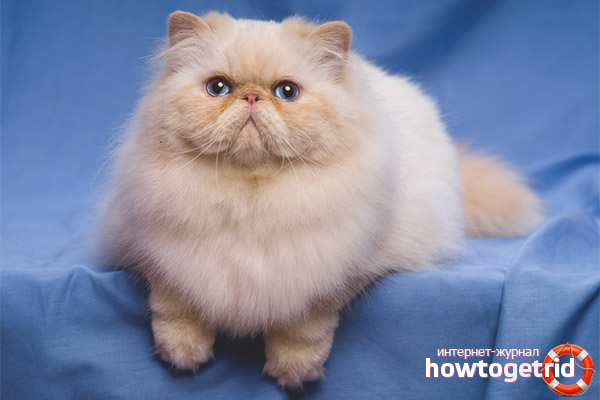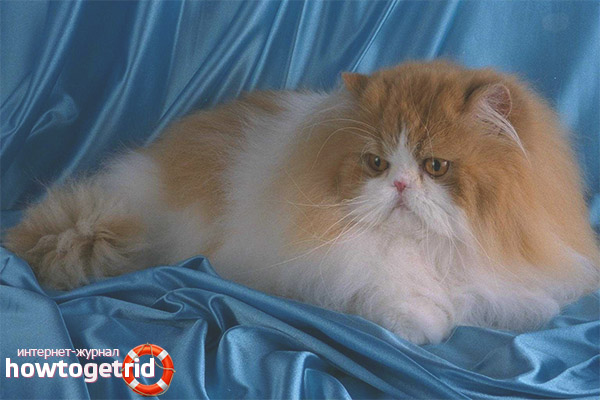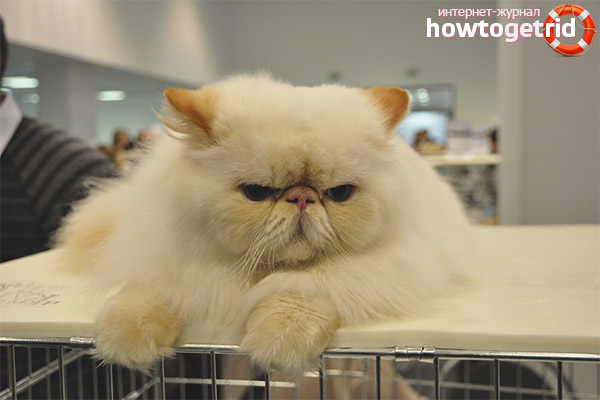The content of the article
The Persian cat is rightfully considered one of the most beautiful breeds in the world. By focusing on these cute and charming animals, you can make yourself a good friend who can decorate your life and improve your mood after a hard day's work. In addition to a luxurious presentable appearance, they are appreciated for their surprisingly attractive character for co-existence. It is he who is the determining factor in choosing a breed and attracts new admirers of the Persian cat.
A small, but rather wide snub-nosed nose allows a cat to stand out among other breeds. According to the form, it is customary to classify the Persians into:
- "Extreme" - with a small upturned nose. Common in America.
- "Classic" - with an elongated upturned nose. They live in European countries.
In the modern world, there are about 100 colors that have spread the mass of varieties. There are a variety of shades: white, black, cream, red, mahogany, lilac and the most incredible colors of the paint palette. They also have beautiful, rich color shades of the eyes, and they are not limited to green and blue, but can be amber, copper, dark orange. Traditionally, eyes and hair are harmoniously combined in color.
The value of Persian kittens in their uniformity. In the coloring, additional shades and spots are not allowed. If, however, in the color, there are inclusions on the legs or tail, head, then these animals are referred to a separate color-point species. It is the variety of colors that complicates the knitting process of this breed, as this complicates the task of preserving the color. The pricing policy in the cat market depends on the purity of color.
The history of the breed
The first long-haired cats appeared in Europe thanks to Della Vall, who brought them from the province of Persia. They did not have much resemblance to the current Persians and looked more like an Angorok or Van. Getting to the new homeland of the habitat, the name of the breed changed: Asian, Russian, Chinese cat ... Cats were brought by tourists as a souvenir from Asia, they shared their observations that this is the result of the crossing of a Pallas cat and a wild velvet cat. The name "Persian cat" is a tribute to the fashion of those times, not related to origin. Long beautiful hair is the result of random crosses and mutations, and the scientific approach and breeding work have given more contrasting differences to the breed similar to those bred as a result of combining Aboriginal individuals with Asian long-haired cats.
In the 19th century, English breeders conditionally divided cats with luxurious long hair into Angora and French. In Germany, the aim of breeding was to obtain a stronger, more massive cat using "longhars" - local breeds and Angora. This was the beginning of the emergence of a popular breed.
A breakthrough in Persian breeding occurred in the 20th century. It is American breeders who should be thankful for a special, cute face. They created a perfect Persian cat in all respects, with childish, kind, touching touches.
In Europe, science also did not give up its positions, and in 1933 a breed was introduced that does not require such careful care as the Persians, but has all the same character traits and reliefs. The new breed “Persian exotic” conquered the world. It differs from the classic short, dense coat like that of a British.
The peculiarity of this breed can be considered an unusual shape of the nose, which gives a certain facial expression to the face.No matter how sad or funny, arrogant or kind, it will look cute in any case.
This is a fairly large animal, whose adults can reach 8 kg. The work of breeders managed to give the breed a wide chest, powerful legs, a large head, large, rounded, brightly expressed eyes. A bright and no less important distinguishing feature is the wool, which is somewhat similar to the lion's mane and sideburns formed on the sides. Chest and tail are embellished with fur frill.
The breed is really chic and able to decorate and ennoble the home, but this beauty requires time and additional care. The cares associated with the care of the coat cannot be postponed until another day or abandoned. Persians require care for their basic virtues daily.
Standard breed requirements
- The head of a Persian cat is massive, but it is proportional to the size of the body. The case is compact, but massive and quite large. With the same parameters, an average is allowed. While the animal is large, it has a shortened dense neck.
- The cheekbones on the face are wide, with pronounced puffy cheeks.
- The highlight of the breed is the nose. He does not protrude forward, flattened, wide and upturned.
- The location of the ears is low. They are small, with rounded edges and are located widely.
- The eyes are large, rounded, wide open.
- Massive, muscular, short, compact paws.
- Dull, rounded off the edge, short, fleshy tail.
Character features of the Persians
Having fallen in love with the external data of the breed, the owner expects a big surprise. There is no better companion for living together. They are gentle, faithful, and at the same time noble. They are complaisant and endowed with meek disposition.
Interesting Facts:
- The breed is bred for existence next to a person. She is not capable of overcoming all the difficulties of street life. Cats become attached to their owner and do not miss the opportunity to comfortably sit on their knees or climb onto their shoulders. They do not tolerate loneliness, and accompany the object of their affection everywhere. Regardless of age, these are playful animals.
- To their greater friendliness and devotion, it is precisely the cats that differ, surprisingly. Females are more freedom-loving and independent, they have less developed need for affection. Kittens are especially worth noting. Only the look and grimaces on the faces can improve mood, and given their fervent disposition and curiosity, you can get a real relaxation after a busy sequence of events of the day.
- If we compare the Persian cat with other breeds, then this breed is the most domestic and faithful. She clearly defines the object of worship for herself and follows on his heels. She can communicate in a soft gentle voice and loves to hug.
- The cat's pleasant voice is not often heard without urgent need. To attract attention, she simply takes a wait-and-see attitude and faithfully looks into her eyes. She will move from room to room until the owner fulfills her silent request.
- Persians are happy to play games with children, and if for some reason they are offended, these good-natured animals do not bear a plan of revenge like Siamese, and certainly they are not vindictive.
- The attribution of the breed to sofa cats is not deserved, since the Persians are not averse to frolic with a ball or to hunt for an accidentally flown insect.
- With all their love for the owner, they do not miss the opportunity to emphasize their importance and noble status.
- Choosing an idol from family members, this cat will focus on who can devote more time to it.
How to ensure proper care
The choice of this breed should be conscious, as it is justifiably considered the most difficult to care for. Persians require daily attention to their royal mane.Otherwise, luxurious wool will gather in balls, and the undercoat will fall off. Together with the cat it will be necessary to acquire several metal combs of different densities and types of teeth, brushes of different hardness, talcum powder for caring for cats, shampoo and conditioners.
Persians consider a constant occurrence of discharge from the corners of the eye, as well as heavy breathing. It is necessary to be prepared for additional manipulations and periodic cleaning of eyes and ears. Choosing a Persian cat requires a serious and responsible approach.
A cat can be very grateful if you find 10-15 minutes daily and one hour a week for her care. It is recommended to do water procedures once every 7 days, wipe your eyes daily. For hygiene purposes, hair should be trimmed on the hind legs and around the anus.
Addiction to disease
Breeders have done serious work to improve the breed. Persians are resistant to many diseases and do not pose any particular problems. Depending on the type, they are rarely exposed to one or another ailment. One of the most serious diseases of the breed is kidney failure, and they are also prone to a hereditary eye disease - progressive retinal atrophy, leading to blindness. The disease is detected at an early age and by the age of 4 months, kittens completely lose their sight.
Animals have an individual feature - increased tearfulness and the effect of a stuffy nose, they also have a number of problems with the oral cavity. They are more prone to gingivitis, the formation of stones and plaque on the teeth, and this requires additional regular examination and complete sanitation of the mouth by specialists. Untimely intervention can lead to the development of periodontitis, tooth loss and destruction of bone tissue.
Like other breeds, the Persians are prone to myocardial diseases, thickening of its walls and disruption of the heart muscle. The disease develops rapidly, and has no age restrictions, can be transmitted at the genetic level. Often this leads to sudden death, especially in older individuals.
If the lifestyle dictates the need to often move from place to place - this breed should be abandoned. They are not adapted and, moreover, they painfully endure travels. The nervous system is stressed, they are nervous and breathing heavily.
The acquisition of a kitten
Persian cats are quite popular, and due to the large number of populations, finding a nursery engaged in breeding Persians will not be difficult.
The main attention should be paid to studying the reputation of the breeder. Driven by a thirst for profit, they often neglect quality and do not show proper care for pets, they are least concerned about the quality of food, living conditions and health. Online purchases are dubious transactions. The best choice can be made by talking directly with the breeder. To get your perfect kitten, you need to consider several nurseries and have a conversation with more than one owner.
It is important to consider that a cat is a living creature that is endowed with its individual character. It may be somewhere different from the standard.
The price of a kitten of this breed can be very different. It is affected by color, elite of the nursery, maintenance, financial standard of living of the village, class of animal.
Video: Persian Cats












Submit